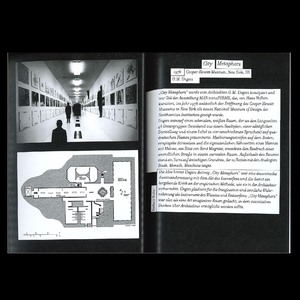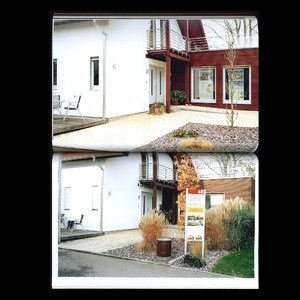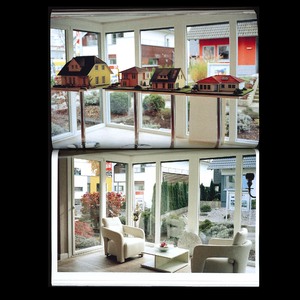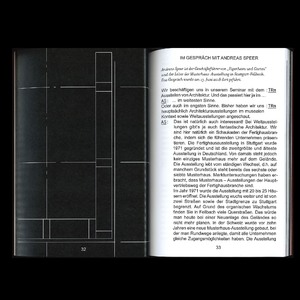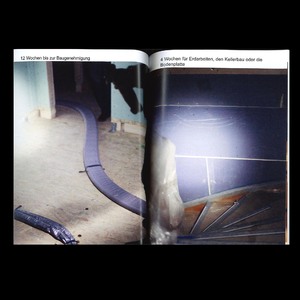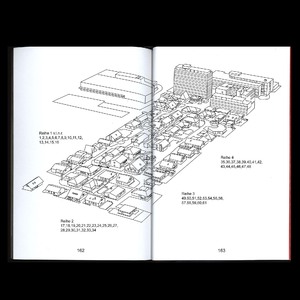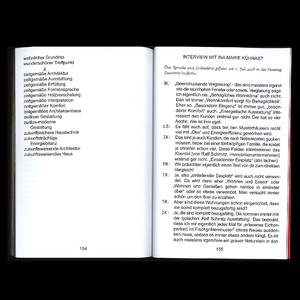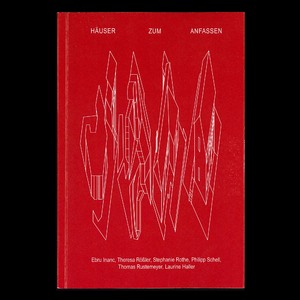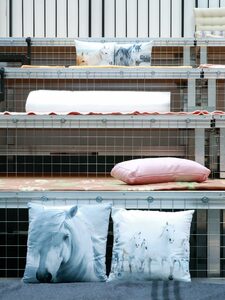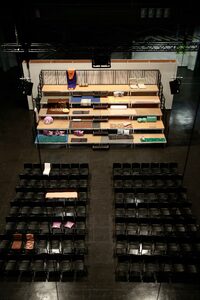Theresa Rößler
| Name | Theresa Rößler |
17 Inhalte
- Seite 1 von 2
Häuser zum Anfassen
- Titel
- Häuser zum Anfassen
- Autor/in
- Beschreibung (de)
- Die Ausstellung “Häuser zum Anfassen“ befasst sich mit dem Ausstellen von Architektur. In künstlerischen Recherchearbeiten verhandelt sie Fragen zur Repräsentation, Medialisierung, Simulation und Aneignung von Architektur anhand der Musterhaus-Ausstellung in Fellbach. Diese wurde 1971 vom Verleger Ottmar Strebel gegründet und ist nach eigener Darstellung die erste ihrer Art in Deutschland. Besucherinnen und Besucher können hier 66 verschiedene, nahezu komplett eingerichtete Musterhäuser besichtigen, begehen und kaufen. So entsteht ein Hybrid aus Ausstellung, Kulissensiedlung und Simulationsarchitektur.
- Beschreibung (en)
- The exhibition "Häuser zum Anfassen" ("Houses to touch") deals with the exhibition of architecture. In artistic works of research, it deals with questions of representation, medialization, simulation and appropriation of architecture based on the model house exhibition in Fellbach. This exhibition was established in 1971 by the publisher Ottmar Strebel and is, by his own account, the first of its kind in Germany. Visitors can view, walk through and purchase 66 different, almost fully furnished show homes. The result is a hybrid of exhibition, scenic estate and simulated architecture.
- Typ des Projekts/Werks
- Schlagworte
- Datierung
- 05.02.2019 - 13.02.2019
- Sprache
- Ort: Institution
- Ort
- Waldstraße 8 76133 Karlsruhe
- Stadt
- Land
- Beteiligte Institution(en)
- Bemerkungen
- Die Vernissage fand am 5.2.19 um 19h statt.
- Titel
- Häuser zum Anfassen
- Urheberrechtshinweis
- HfG Karlsruhe
- Rechtsschutz/Lizenz
- Medienersteller/in
- Projektleiter/in
- Semester
- Lehrveranstaltung
- Importiert am
- 29.06.2023
- Übergeordnete Sets
- 1
Häuser zum Anfassen
- Titel
- Häuser zum Anfassen
- Autor/in
- Beschreibung (de)
- Die Ausstellung “Häuser zum Anfassen“ befasst sich mit dem Ausstellen von Architektur. In künstlerischen Recherchearbeiten verhandelt sie Fragen zur Repräsentation, Medialisierung, Simulation und Aneignung von Architektur anhand der Musterhaus-Ausstellung in Fellbach. Diese wurde 1971 vom Verleger Ottmar Strebel gegründet und ist nach eigener Darstellung die erste ihrer Art in Deutschland. Besucherinnen und Besucher können hier 66 verschiedene, nahezu komplett eingerichtete Musterhäuser besichtigen, begehen und kaufen. So entsteht ein Hybrid aus Ausstellung, Kulissensiedlung und Simulationsarchitektur.
- Beschreibung (en)
- The exhibition "Häuser zum Anfassen" ("Houses to touch") deals with the exhibition of architecture. In artistic works of research, it deals with questions of representation, medialization, simulation and appropriation of architecture based on the model house exhibition in Fellbach. This exhibition was established in 1971 by the publisher Ottmar Strebel and is, by his own account, the first of its kind in Germany. Visitors can view, walk through and purchase 66 different, almost fully furnished show homes. The result is a hybrid of exhibition, scenic estate and simulated architecture.
- Typ des Projekts/Werks
- Schlagworte
- Datierung
- 05.02.2019 - 13.02.2019
- Sprache
- Ort: Institution
- Ort
- Waldstraße 8 76133 Karlsruhe
- Stadt
- Land
- Beteiligte Institution(en)
- Bemerkungen
- Die Vernissage fand am 5.2.19 um 19h statt.
- Titel
- Häuser zum Anfassen
- Urheberrechtshinweis
- HfG Karlsruhe
- Rechtsschutz/Lizenz
- Medienersteller/in
- Projektleiter/in
- Semester
- Lehrveranstaltung
- Importiert am
- 29.06.2023
- Übergeordnete Sets
- 1
Häuser zum Anfassen
- Titel
- Häuser zum Anfassen
- Autor/in
- Beschreibung (de)
- Die Ausstellung “Häuser zum Anfassen“ befasst sich mit dem Ausstellen von Architektur. In künstlerischen Recherchearbeiten verhandelt sie Fragen zur Repräsentation, Medialisierung, Simulation und Aneignung von Architektur anhand der Musterhaus-Ausstellung in Fellbach. Diese wurde 1971 vom Verleger Ottmar Strebel gegründet und ist nach eigener Darstellung die erste ihrer Art in Deutschland. Besucherinnen und Besucher können hier 66 verschiedene, nahezu komplett eingerichtete Musterhäuser besichtigen, begehen und kaufen. So entsteht ein Hybrid aus Ausstellung, Kulissensiedlung und Simulationsarchitektur.
- Beschreibung (en)
- The exhibition "Häuser zum Anfassen" ("Houses to touch") deals with the exhibition of architecture. In artistic works of research, it deals with questions of representation, medialization, simulation and appropriation of architecture based on the model house exhibition in Fellbach. This exhibition was established in 1971 by the publisher Ottmar Strebel and is, by his own account, the first of its kind in Germany. Visitors can view, walk through and purchase 66 different, almost fully furnished show homes. The result is a hybrid of exhibition, scenic estate and simulated architecture.
- Typ des Projekts/Werks
- Schlagworte
- Datierung
- 05.02.2019 - 13.02.2019
- Sprache
- Ort: Institution
- Ort
- Waldstraße 8 76133 Karlsruhe
- Stadt
- Land
- Beteiligte Institution(en)
- Bemerkungen
- Die Vernissage fand am 5.2.19 um 19h statt.
- Titel
- Häuser zum Anfassen
- Urheberrechtshinweis
- HfG Karlsruhe
- Rechtsschutz/Lizenz
- Medienersteller/in
- Projektleiter/in
- Semester
- Lehrveranstaltung
- Importiert am
- 29.06.2023
- Übergeordnete Sets
- 1
Häuser zum Anfassen
- Titel
- Häuser zum Anfassen
- Autor/in
- Beschreibung (de)
- Die Ausstellung “Häuser zum Anfassen“ befasst sich mit dem Ausstellen von Architektur. In künstlerischen Recherchearbeiten verhandelt sie Fragen zur Repräsentation, Medialisierung, Simulation und Aneignung von Architektur anhand der Musterhaus-Ausstellung in Fellbach. Diese wurde 1971 vom Verleger Ottmar Strebel gegründet und ist nach eigener Darstellung die erste ihrer Art in Deutschland. Besucherinnen und Besucher können hier 66 verschiedene, nahezu komplett eingerichtete Musterhäuser besichtigen, begehen und kaufen. So entsteht ein Hybrid aus Ausstellung, Kulissensiedlung und Simulationsarchitektur.
- Beschreibung (en)
- The exhibition "Häuser zum Anfassen" ("Houses to touch") deals with the exhibition of architecture. In artistic works of research, it deals with questions of representation, medialization, simulation and appropriation of architecture based on the model house exhibition in Fellbach. This exhibition was established in 1971 by the publisher Ottmar Strebel and is, by his own account, the first of its kind in Germany. Visitors can view, walk through and purchase 66 different, almost fully furnished show homes. The result is a hybrid of exhibition, scenic estate and simulated architecture.
- Typ des Projekts/Werks
- Schlagworte
- Datierung
- 05.02.2019 - 13.02.2019
- Sprache
- Ort: Institution
- Ort
- Waldstraße 8 76133 Karlsruhe
- Stadt
- Land
- Beteiligte Institution(en)
- Bemerkungen
- Die Vernissage fand am 5.2.19 um 19h statt.
- Titel
- Häuser zum Anfassen
- Urheberrechtshinweis
- HfG Karlsruhe
- Rechtsschutz/Lizenz
- Medienersteller/in
- Projektleiter/in
- Semester
- Lehrveranstaltung
- Importiert am
- 29.06.2023
- Übergeordnete Sets
- 1
Häuser zum Anfassen
- Titel
- Häuser zum Anfassen
- Autor/in
- Beschreibung (de)
- Die Ausstellung “Häuser zum Anfassen“ befasst sich mit dem Ausstellen von Architektur. In künstlerischen Recherchearbeiten verhandelt sie Fragen zur Repräsentation, Medialisierung, Simulation und Aneignung von Architektur anhand der Musterhaus-Ausstellung in Fellbach. Diese wurde 1971 vom Verleger Ottmar Strebel gegründet und ist nach eigener Darstellung die erste ihrer Art in Deutschland. Besucherinnen und Besucher können hier 66 verschiedene, nahezu komplett eingerichtete Musterhäuser besichtigen, begehen und kaufen. So entsteht ein Hybrid aus Ausstellung, Kulissensiedlung und Simulationsarchitektur.
- Beschreibung (en)
- The exhibition "Häuser zum Anfassen" ("Houses to touch") deals with the exhibition of architecture. In artistic works of research, it deals with questions of representation, medialization, simulation and appropriation of architecture based on the model house exhibition in Fellbach. This exhibition was established in 1971 by the publisher Ottmar Strebel and is, by his own account, the first of its kind in Germany. Visitors can view, walk through and purchase 66 different, almost fully furnished show homes. The result is a hybrid of exhibition, scenic estate and simulated architecture.
- Typ des Projekts/Werks
- Schlagworte
- Datierung
- 05.02.2019 - 13.02.2019
- Sprache
- Ort: Institution
- Ort
- Waldstraße 8 76133 Karlsruhe
- Stadt
- Land
- Beteiligte Institution(en)
- Bemerkungen
- Die Vernissage fand am 5.2.19 um 19h statt.
- Titel
- Häuser zum Anfassen
- Urheberrechtshinweis
- HfG Karlsruhe
- Rechtsschutz/Lizenz
- Medienersteller/in
- Projektleiter/in
- Semester
- Lehrveranstaltung
- Importiert am
- 29.06.2023
- Übergeordnete Sets
- 1
Häuser zum Anfassen
- Titel
- Häuser zum Anfassen
- Autor/in
- Beschreibung (de)
- Die Ausstellung “Häuser zum Anfassen“ befasst sich mit dem Ausstellen von Architektur. In künstlerischen Recherchearbeiten verhandelt sie Fragen zur Repräsentation, Medialisierung, Simulation und Aneignung von Architektur anhand der Musterhaus-Ausstellung in Fellbach. Diese wurde 1971 vom Verleger Ottmar Strebel gegründet und ist nach eigener Darstellung die erste ihrer Art in Deutschland. Besucherinnen und Besucher können hier 66 verschiedene, nahezu komplett eingerichtete Musterhäuser besichtigen, begehen und kaufen. So entsteht ein Hybrid aus Ausstellung, Kulissensiedlung und Simulationsarchitektur.
- Beschreibung (en)
- The exhibition "Häuser zum Anfassen" ("Houses to touch") deals with the exhibition of architecture. In artistic works of research, it deals with questions of representation, medialization, simulation and appropriation of architecture based on the model house exhibition in Fellbach. This exhibition was established in 1971 by the publisher Ottmar Strebel and is, by his own account, the first of its kind in Germany. Visitors can view, walk through and purchase 66 different, almost fully furnished show homes. The result is a hybrid of exhibition, scenic estate and simulated architecture.
- Typ des Projekts/Werks
- Schlagworte
- Datierung
- 05.02.2019 - 13.02.2019
- Sprache
- Ort: Institution
- Ort
- Waldstraße 8 76133 Karlsruhe
- Stadt
- Land
- Beteiligte Institution(en)
- Bemerkungen
- Die Vernissage fand am 5.2.19 um 19h statt.
- Titel
- Häuser zum Anfassen
- Urheberrechtshinweis
- HfG Karlsruhe
- Rechtsschutz/Lizenz
- Medienersteller/in
- Projektleiter/in
- Semester
- Lehrveranstaltung
- Importiert am
- 29.06.2023
- Übergeordnete Sets
- 1
Häuser zum Anfassen
- Titel
- Häuser zum Anfassen
- Autor/in
- Beschreibung (de)
- Die Ausstellung “Häuser zum Anfassen“ befasst sich mit dem Ausstellen von Architektur. In künstlerischen Recherchearbeiten verhandelt sie Fragen zur Repräsentation, Medialisierung, Simulation und Aneignung von Architektur anhand der Musterhaus-Ausstellung in Fellbach. Diese wurde 1971 vom Verleger Ottmar Strebel gegründet und ist nach eigener Darstellung die erste ihrer Art in Deutschland. Besucherinnen und Besucher können hier 66 verschiedene, nahezu komplett eingerichtete Musterhäuser besichtigen, begehen und kaufen. So entsteht ein Hybrid aus Ausstellung, Kulissensiedlung und Simulationsarchitektur.
- Beschreibung (en)
- The exhibition "Häuser zum Anfassen" ("Houses to touch") deals with the exhibition of architecture. In artistic works of research, it deals with questions of representation, medialization, simulation and appropriation of architecture based on the model house exhibition in Fellbach. This exhibition was established in 1971 by the publisher Ottmar Strebel and is, by his own account, the first of its kind in Germany. Visitors can view, walk through and purchase 66 different, almost fully furnished show homes. The result is a hybrid of exhibition, scenic estate and simulated architecture.
- Typ des Projekts/Werks
- Schlagworte
- Datierung
- 05.02.2019 - 13.02.2019
- Sprache
- Ort: Institution
- Ort
- Waldstraße 8 76133 Karlsruhe
- Stadt
- Land
- Beteiligte Institution(en)
- Bemerkungen
- Die Vernissage fand am 5.2.19 um 19h statt.
- Titel
- Häuser zum Anfassen
- Urheberrechtshinweis
- HfG Karlsruhe
- Rechtsschutz/Lizenz
- Medienersteller/in
- Projektleiter/in
- Semester
- Lehrveranstaltung
- Importiert am
- 29.06.2023
- Übergeordnete Sets
- 1
Häuser zum Anfassen
- Titel
- Häuser zum Anfassen
- Autor/in
- Beschreibung (de)
- Die Ausstellung “Häuser zum Anfassen“ befasst sich mit dem Ausstellen von Architektur. In künstlerischen Recherchearbeiten verhandelt sie Fragen zur Repräsentation, Medialisierung, Simulation und Aneignung von Architektur anhand der Musterhaus-Ausstellung in Fellbach. Diese wurde 1971 vom Verleger Ottmar Strebel gegründet und ist nach eigener Darstellung die erste ihrer Art in Deutschland. Besucherinnen und Besucher können hier 66 verschiedene, nahezu komplett eingerichtete Musterhäuser besichtigen, begehen und kaufen. So entsteht ein Hybrid aus Ausstellung, Kulissensiedlung und Simulationsarchitektur.
- Beschreibung (en)
- The exhibition "Häuser zum Anfassen" ("Houses to touch") deals with the exhibition of architecture. In artistic works of research, it deals with questions of representation, medialization, simulation and appropriation of architecture based on the model house exhibition in Fellbach. This exhibition was established in 1971 by the publisher Ottmar Strebel and is, by his own account, the first of its kind in Germany. Visitors can view, walk through and purchase 66 different, almost fully furnished show homes. The result is a hybrid of exhibition, scenic estate and simulated architecture.
- Typ des Projekts/Werks
- Schlagworte
- Datierung
- 05.02.2019 - 13.02.2019
- Sprache
- Ort: Institution
- Ort
- Waldstraße 8 76133 Karlsruhe
- Stadt
- Land
- Beteiligte Institution(en)
- Bemerkungen
- Die Vernissage fand am 5.2.19 um 19h statt.
- Titel
- Häuser zum Anfassen
- Urheberrechtshinweis
- HfG Karlsruhe
- Rechtsschutz/Lizenz
- Medienersteller/in
- Projektleiter/in
- Semester
- Lehrveranstaltung
- Importiert am
- 29.06.2023
- Übergeordnete Sets
- 1
Häuser zum Anfassen
- Titel
- Häuser zum Anfassen
- Autor/in
- Beschreibung (de)
- Die Ausstellung “Häuser zum Anfassen“ befasst sich mit dem Ausstellen von Architektur. In künstlerischen Recherchearbeiten verhandelt sie Fragen zur Repräsentation, Medialisierung, Simulation und Aneignung von Architektur anhand der Musterhaus-Ausstellung in Fellbach. Diese wurde 1971 vom Verleger Ottmar Strebel gegründet und ist nach eigener Darstellung die erste ihrer Art in Deutschland. Besucherinnen und Besucher können hier 66 verschiedene, nahezu komplett eingerichtete Musterhäuser besichtigen, begehen und kaufen. So entsteht ein Hybrid aus Ausstellung, Kulissensiedlung und Simulationsarchitektur.
- Beschreibung (en)
- The exhibition "Häuser zum Anfassen" ("Houses to touch") deals with the exhibition of architecture. In artistic works of research, it deals with questions of representation, medialization, simulation and appropriation of architecture based on the model house exhibition in Fellbach. This exhibition was established in 1971 by the publisher Ottmar Strebel and is, by his own account, the first of its kind in Germany. Visitors can view, walk through and purchase 66 different, almost fully furnished show homes. The result is a hybrid of exhibition, scenic estate and simulated architecture.
- Typ des Projekts/Werks
- Schlagworte
- Datierung
- 05.02.2019 - 13.02.2019
- Sprache
- Ort: Institution
- Ort
- Waldstraße 8 76133 Karlsruhe
- Stadt
- Land
- Beteiligte Institution(en)
- Bemerkungen
- Die Vernissage fand am 5.2.19 um 19h statt.
- Titel
- Häuser zum Anfassen
- Urheberrechtshinweis
- HfG Karlsruhe
- Rechtsschutz/Lizenz
- Medienersteller/in
- Projektleiter/in
- Semester
- Lehrveranstaltung
- Importiert am
- 29.06.2023
- Übergeordnete Sets
- 1
Matters of Communication
- Titel
- Matters of Communication
- Titel (en)
- Matters of Communication
- Untertitel
- 15th annual meeting of the German Society for Design Theory and Research
- Untertitel des Projekts/Werks (en)
- 15th annual meeting of the German Society for Design Theory and Research
- Autor/in
- Beschreibung (de)
- Ob Raum, Bild, Text, Objekt oder System - Design ist immer auch Kommunikation. Vor dem Hintergrund der zunehmenden Radikalisierung, Segmentierung und Polemisierung gesellschaftlicher Diskurse scheint das Verhältnis von Design und Kommunikation heute brisanter denn je. Ständig entstehen neue Kommunikationsmedien, -kanäle, -räume und -systeme. Maschinen, Objekte, ja ganze Umgebungen werden zu eigenständigen Akteuren, die mit uns kommunizieren und auf verschiedenen medialen Ebenen interagieren. Wie können wir die Kontexte, die Möglichkeitsbedingungen und Wirkungszusammenhänge im Hinblick auf gestaltete Kommunikation ausloten? Welche Konzepte werden benötigt, um das Verhältnis von Design und Kommunikation aus heutiger Sicht zu konzeptualisieren?
Die DGTF-Konferenz "Matters of Communication" schafft einen Raum für die Diskussion darüber, wie Kommunikation heute gestaltet wird und wie Design heute kommuniziert wird. Welches sind die wegweisenden Ansätze und Methoden der Designforschung in Bezug auf Kommunikation durch und in zeitgenössischen Ausdrucksformen sowie kultureller und wirtschaftlicher Produktion? Wie reflektieren Forschungsprojekte "Matters of Communication", d.h. die Form und Materialität gestalteter Kommunikation, und ihre Rolle bei der Entstehung von Zuschreibungen und Interpretationskontexten? Welche Rolle spielt die Designforschung bei der Entwicklung von relevanten Fragestellungen und Lösungen? Wie erfolgt die Theoriebildung und Umsetzung in Lehre und Praxis?
- Ob Raum, Bild, Text, Objekt oder System - Design ist immer auch Kommunikation. Vor dem Hintergrund der zunehmenden Radikalisierung, Segmentierung und Polemisierung gesellschaftlicher Diskurse scheint das Verhältnis von Design und Kommunikation heute brisanter denn je. Ständig entstehen neue Kommunikationsmedien, -kanäle, -räume und -systeme. Maschinen, Objekte, ja ganze Umgebungen werden zu eigenständigen Akteuren, die mit uns kommunizieren und auf verschiedenen medialen Ebenen interagieren. Wie können wir die Kontexte, die Möglichkeitsbedingungen und Wirkungszusammenhänge im Hinblick auf gestaltete Kommunikation ausloten? Welche Konzepte werden benötigt, um das Verhältnis von Design und Kommunikation aus heutiger Sicht zu konzeptualisieren?
- Beschreibung (en)
- Whether space, image, text, object or system — design is always also communication. Against the backdrop of increasing radicalization, segmentation and polemization of social discourses, the relationship between design and communication seems more volatile today than ever. New communications media, channels, spaces and systems are constantly emerging. Machines, objects, even entire environments become independent actors that communicate with us and interact on various media levels. How can we sound out the contexts, the conditions that lead to possibility and the interdependencies of impact with regard to designed communication? What concepts are needed to conceptualize the relationship between design and communication from a present-day point of view?
The DGTF conference “Matters of Communication” creates a space for discussion about how communication is designed today and how design is communicated today. What are the pioneering approaches and methods of design research in relation to communication through and within contemporary forms of expression, as well as cultural and economic production? How do research projects reflect “Matters of Communication”, i.e. the form and materiality of designed communication, and their role in the emergence of attributions and interpretation contexts? What is the role that design research plays in the development of relevant questions and solutions? How is theory formation and translation into teaching and practice carried out?
- Whether space, image, text, object or system — design is always also communication. Against the backdrop of increasing radicalization, segmentation and polemization of social discourses, the relationship between design and communication seems more volatile today than ever. New communications media, channels, spaces and systems are constantly emerging. Machines, objects, even entire environments become independent actors that communicate with us and interact on various media levels. How can we sound out the contexts, the conditions that lead to possibility and the interdependencies of impact with regard to designed communication? What concepts are needed to conceptualize the relationship between design and communication from a present-day point of view?
- Typ des Projekts/Werks
- Schlagworte
- Datierung
- 16.11.2018 - 18.11.2018
- Mitwirkende
- Sprache
- Ort: Institution
- Ort
- Lichthöfe
- Stadt
- Land
- Beteiligte Institution(en)
- Internetlinks
- Bemerkungen
- Graphik-Design: Lena Haselmann and Catharina Grözinger, © DGTF
- Titel
- Matters of Communication
- Urheberrechtshinweis
- Vera Gärtner, Jana Hofmann, Calvin Kudufia
- Rechtsschutz/Lizenz
- Medienersteller/in
- Projektleiter/in
- Semester
- Lehrveranstaltung
- Importiert am
- 21.06.2023
- Übergeordnete Sets
- 1
Matters of Communication
- Titel
- Matters of Communication
- Titel (en)
- Matters of Communication
- Untertitel
- 15th annual meeting of the German Society for Design Theory and Research
- Untertitel des Projekts/Werks (en)
- 15th annual meeting of the German Society for Design Theory and Research
- Autor/in
- Beschreibung (de)
- Ob Raum, Bild, Text, Objekt oder System - Design ist immer auch Kommunikation. Vor dem Hintergrund der zunehmenden Radikalisierung, Segmentierung und Polemisierung gesellschaftlicher Diskurse scheint das Verhältnis von Design und Kommunikation heute brisanter denn je. Ständig entstehen neue Kommunikationsmedien, -kanäle, -räume und -systeme. Maschinen, Objekte, ja ganze Umgebungen werden zu eigenständigen Akteuren, die mit uns kommunizieren und auf verschiedenen medialen Ebenen interagieren. Wie können wir die Kontexte, die Möglichkeitsbedingungen und Wirkungszusammenhänge im Hinblick auf gestaltete Kommunikation ausloten? Welche Konzepte werden benötigt, um das Verhältnis von Design und Kommunikation aus heutiger Sicht zu konzeptualisieren?
Die DGTF-Konferenz "Matters of Communication" schafft einen Raum für die Diskussion darüber, wie Kommunikation heute gestaltet wird und wie Design heute kommuniziert wird. Welches sind die wegweisenden Ansätze und Methoden der Designforschung in Bezug auf Kommunikation durch und in zeitgenössischen Ausdrucksformen sowie kultureller und wirtschaftlicher Produktion? Wie reflektieren Forschungsprojekte "Matters of Communication", d.h. die Form und Materialität gestalteter Kommunikation, und ihre Rolle bei der Entstehung von Zuschreibungen und Interpretationskontexten? Welche Rolle spielt die Designforschung bei der Entwicklung von relevanten Fragestellungen und Lösungen? Wie erfolgt die Theoriebildung und Umsetzung in Lehre und Praxis?
- Ob Raum, Bild, Text, Objekt oder System - Design ist immer auch Kommunikation. Vor dem Hintergrund der zunehmenden Radikalisierung, Segmentierung und Polemisierung gesellschaftlicher Diskurse scheint das Verhältnis von Design und Kommunikation heute brisanter denn je. Ständig entstehen neue Kommunikationsmedien, -kanäle, -räume und -systeme. Maschinen, Objekte, ja ganze Umgebungen werden zu eigenständigen Akteuren, die mit uns kommunizieren und auf verschiedenen medialen Ebenen interagieren. Wie können wir die Kontexte, die Möglichkeitsbedingungen und Wirkungszusammenhänge im Hinblick auf gestaltete Kommunikation ausloten? Welche Konzepte werden benötigt, um das Verhältnis von Design und Kommunikation aus heutiger Sicht zu konzeptualisieren?
- Beschreibung (en)
- Whether space, image, text, object or system — design is always also communication. Against the backdrop of increasing radicalization, segmentation and polemization of social discourses, the relationship between design and communication seems more volatile today than ever. New communications media, channels, spaces and systems are constantly emerging. Machines, objects, even entire environments become independent actors that communicate with us and interact on various media levels. How can we sound out the contexts, the conditions that lead to possibility and the interdependencies of impact with regard to designed communication? What concepts are needed to conceptualize the relationship between design and communication from a present-day point of view?
The DGTF conference “Matters of Communication” creates a space for discussion about how communication is designed today and how design is communicated today. What are the pioneering approaches and methods of design research in relation to communication through and within contemporary forms of expression, as well as cultural and economic production? How do research projects reflect “Matters of Communication”, i.e. the form and materiality of designed communication, and their role in the emergence of attributions and interpretation contexts? What is the role that design research plays in the development of relevant questions and solutions? How is theory formation and translation into teaching and practice carried out?
- Whether space, image, text, object or system — design is always also communication. Against the backdrop of increasing radicalization, segmentation and polemization of social discourses, the relationship between design and communication seems more volatile today than ever. New communications media, channels, spaces and systems are constantly emerging. Machines, objects, even entire environments become independent actors that communicate with us and interact on various media levels. How can we sound out the contexts, the conditions that lead to possibility and the interdependencies of impact with regard to designed communication? What concepts are needed to conceptualize the relationship between design and communication from a present-day point of view?
- Typ des Projekts/Werks
- Schlagworte
- Datierung
- 16.11.2018 - 18.11.2018
- Mitwirkende
- Sprache
- Ort: Institution
- Ort
- Lichthöfe
- Stadt
- Land
- Beteiligte Institution(en)
- Internetlinks
- Bemerkungen
- Graphik-Design: Lena Haselmann and Catharina Grözinger, © DGTF
- Titel
- Matters of Communication
- Urheberrechtshinweis
- Vera Gärtner, Jana Hofmann, Calvin Kudufia
- Rechtsschutz/Lizenz
- Medienersteller/in
- Projektleiter/in
- Semester
- Lehrveranstaltung
- Importiert am
- 21.06.2023
- Übergeordnete Sets
- 1
Matters of Communication
- Titel
- Matters of Communication
- Titel (en)
- Matters of Communication
- Untertitel
- 15th annual meeting of the German Society for Design Theory and Research
- Untertitel des Projekts/Werks (en)
- 15th annual meeting of the German Society for Design Theory and Research
- Autor/in
- Beschreibung (de)
- Ob Raum, Bild, Text, Objekt oder System - Design ist immer auch Kommunikation. Vor dem Hintergrund der zunehmenden Radikalisierung, Segmentierung und Polemisierung gesellschaftlicher Diskurse scheint das Verhältnis von Design und Kommunikation heute brisanter denn je. Ständig entstehen neue Kommunikationsmedien, -kanäle, -räume und -systeme. Maschinen, Objekte, ja ganze Umgebungen werden zu eigenständigen Akteuren, die mit uns kommunizieren und auf verschiedenen medialen Ebenen interagieren. Wie können wir die Kontexte, die Möglichkeitsbedingungen und Wirkungszusammenhänge im Hinblick auf gestaltete Kommunikation ausloten? Welche Konzepte werden benötigt, um das Verhältnis von Design und Kommunikation aus heutiger Sicht zu konzeptualisieren?
Die DGTF-Konferenz "Matters of Communication" schafft einen Raum für die Diskussion darüber, wie Kommunikation heute gestaltet wird und wie Design heute kommuniziert wird. Welches sind die wegweisenden Ansätze und Methoden der Designforschung in Bezug auf Kommunikation durch und in zeitgenössischen Ausdrucksformen sowie kultureller und wirtschaftlicher Produktion? Wie reflektieren Forschungsprojekte "Matters of Communication", d.h. die Form und Materialität gestalteter Kommunikation, und ihre Rolle bei der Entstehung von Zuschreibungen und Interpretationskontexten? Welche Rolle spielt die Designforschung bei der Entwicklung von relevanten Fragestellungen und Lösungen? Wie erfolgt die Theoriebildung und Umsetzung in Lehre und Praxis?
- Ob Raum, Bild, Text, Objekt oder System - Design ist immer auch Kommunikation. Vor dem Hintergrund der zunehmenden Radikalisierung, Segmentierung und Polemisierung gesellschaftlicher Diskurse scheint das Verhältnis von Design und Kommunikation heute brisanter denn je. Ständig entstehen neue Kommunikationsmedien, -kanäle, -räume und -systeme. Maschinen, Objekte, ja ganze Umgebungen werden zu eigenständigen Akteuren, die mit uns kommunizieren und auf verschiedenen medialen Ebenen interagieren. Wie können wir die Kontexte, die Möglichkeitsbedingungen und Wirkungszusammenhänge im Hinblick auf gestaltete Kommunikation ausloten? Welche Konzepte werden benötigt, um das Verhältnis von Design und Kommunikation aus heutiger Sicht zu konzeptualisieren?
- Beschreibung (en)
- Whether space, image, text, object or system — design is always also communication. Against the backdrop of increasing radicalization, segmentation and polemization of social discourses, the relationship between design and communication seems more volatile today than ever. New communications media, channels, spaces and systems are constantly emerging. Machines, objects, even entire environments become independent actors that communicate with us and interact on various media levels. How can we sound out the contexts, the conditions that lead to possibility and the interdependencies of impact with regard to designed communication? What concepts are needed to conceptualize the relationship between design and communication from a present-day point of view?
The DGTF conference “Matters of Communication” creates a space for discussion about how communication is designed today and how design is communicated today. What are the pioneering approaches and methods of design research in relation to communication through and within contemporary forms of expression, as well as cultural and economic production? How do research projects reflect “Matters of Communication”, i.e. the form and materiality of designed communication, and their role in the emergence of attributions and interpretation contexts? What is the role that design research plays in the development of relevant questions and solutions? How is theory formation and translation into teaching and practice carried out?
- Whether space, image, text, object or system — design is always also communication. Against the backdrop of increasing radicalization, segmentation and polemization of social discourses, the relationship between design and communication seems more volatile today than ever. New communications media, channels, spaces and systems are constantly emerging. Machines, objects, even entire environments become independent actors that communicate with us and interact on various media levels. How can we sound out the contexts, the conditions that lead to possibility and the interdependencies of impact with regard to designed communication? What concepts are needed to conceptualize the relationship between design and communication from a present-day point of view?
- Typ des Projekts/Werks
- Schlagworte
- Datierung
- 16.11.2018 - 18.11.2018
- Mitwirkende
- Sprache
- Ort: Institution
- Ort
- Lichthöfe
- Stadt
- Land
- Beteiligte Institution(en)
- Internetlinks
- Bemerkungen
- Graphik-Design: Lena Haselmann and Catharina Grözinger, © DGTF
- Titel
- Matters of Communication
- Urheberrechtshinweis
- Vera Gärtner, Jana Hofmann, Calvin Kudufia
- Rechtsschutz/Lizenz
- Medienersteller/in
- Projektleiter/in
- Semester
- Lehrveranstaltung
- Importiert am
- 21.06.2023
- Übergeordnete Sets
- 1
